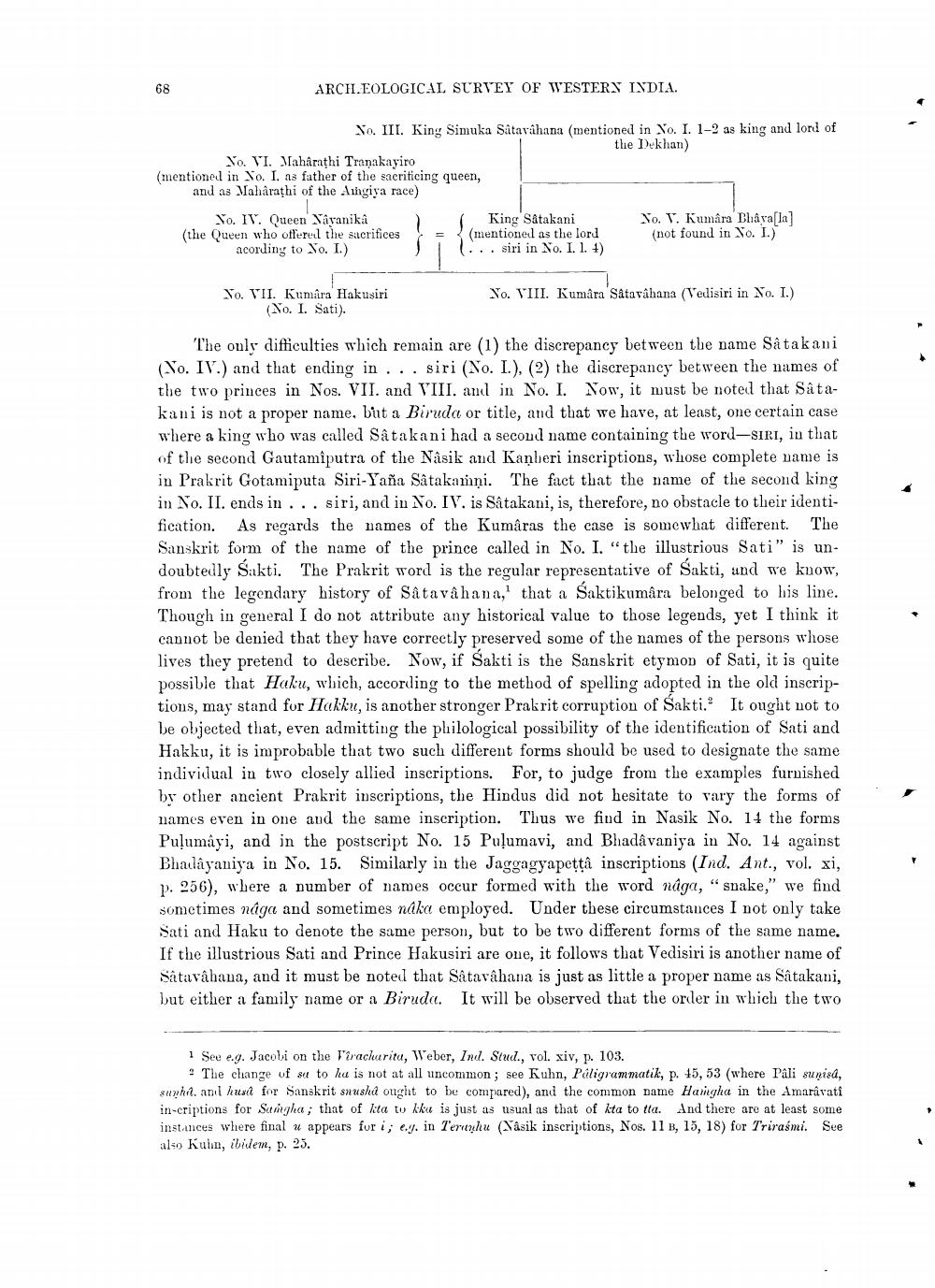________________
ARCHEOLOGICAL SURVEY OF WESTERN INDIA.
X. III. King Simuka Satavahana (mentioned in Yo. I. 1-2 as king and lord of
the Dekhan) No. VI. Maharathi Tranakayiro (mentioned in No. I. as father of the sacriticing queen,
and as Maharathi of the Aingiva race)
Yo. IV. Queen Sayanika (the Queen who offertil the sacrifices
acording to No. I.)
King Satakani {(mentioned as the lord T... siri in Xo. I. 1. )
Yo. V. Kumara Blavalla (not found in Xo. I.)
=
Yo. VII. Kumâra Hakusiri
(No. I. Sati).
No. VIII. Kumara Satavahana (Vedisiri in No. I.)
The only difficulties which remain are (1) the discrepancy between the name Satakani (No. IV.) and that ending in ... siri (No. I.), (2) the discrepancy between the names of the two princes in Nos. VII. and VIII. and in No. I. Now, it must be noted that Satakani is not a proper name, but a Biruda or title, and that we have, at least, one certain case where a king who was called Satakani had a second name containing the word-siri, in that of the second Gautamiputra of the Nâsik and Kamberi inscriptions, whose complete name is in Prakrit Gotamiputa Siri-Yaña Satakamņi. The fact that the name of the second king in No. II. ends in ... siri, and in No. IV. is Satakani, is, therefore, no obstacle to their identification. As regards the names of the Kumâras the case is somewhat different. The Sanskrit form of the name of the prince called in No. I. "the illustrious Sati" is undoubtedly Sakti. The Prakrit word is the regular representative of Sakti, und we know, from the legendary history of Satavahana,' that a Saktikumâra belonged to his line. Though in general I do not attribute any historical value to those legends, yet I think it cannot be denied that they have correctly preserved some of the names of the persons whose lives they pretend to describe. Now, if Sakti is the Sanskrit etymon of Sati, it is quite possible that Haku, which, according to the method of spelling adopted in the old inscriptions, may stand for Hakku, is another stronger Prakrit corruption of Sakti. It ought not to be objected that, even admitting the philological possibility of the identification of Sati and Hakku, it is improbable that two such different forms should be used to designate the same individual in two closely allied inscriptions. For, to judge from the examples furnished by other ancient Prakrit inscriptions, the Hindus did not hesitate to vary the forms of names even in one and the same inscription. Thus we find in Nasik No. 14 the forms Puļumâyi, and in the postscript No. 15 Puļumavi, and Bhadâvaniya in No. 14 against Bhadâyaniya in No. 15. Similarly in the Jaggagyapetta inscriptions (Ind. Ant., vol. xi, p. 256), where a number of names occur formed with the word någa, "snake," we find sometimes någa and sometimes náka employed. Under these circumstances I not only take Sati and Haku to denote the same person, but to be two different forms of the same name. If the illustrious Sati and Prince Hakusiri are one, it follows that Vedisiri is another name of Satavahana, and it must be noted that Satavahana is just as little a proper name as Satakani, but either a family name or a Biruda. It will be observed that the order in which the two
1 See e.g. Jacobi on the trachurita, Weber, Indl. Stud., vol. xiv, p. 103.
The change of su to ha is not at all uncommon; see Kuhn, Påligrammatik, p. 45, 53 (where Pali sunisa, sunhil. anil huse for Sanskrit snushů ought to be compared), and the common name Hargha in the Amaravati in-criptions for Sangha; that of kta tu kku is just as usual as that of kta to tta. And there are at least some instances where final u appears for i; e.y. in Terrahu (Nasik inscriptions, Nos. 11 B, 15, 18) for Triraśmi. See also Kulin, ibidem, p. 25.




